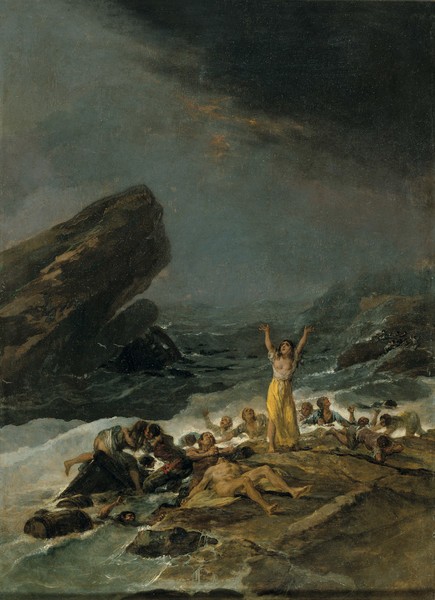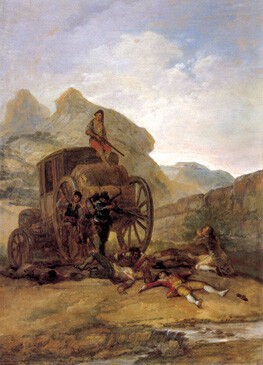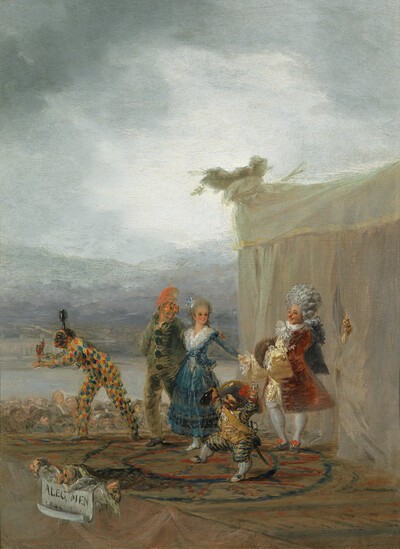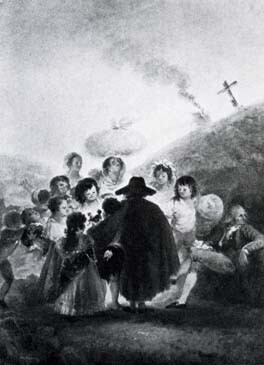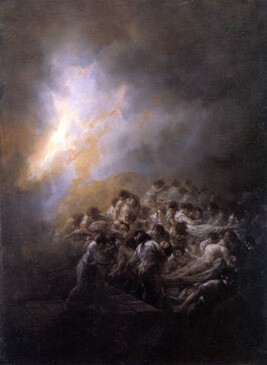- Cronología
- 1793 - 1794
- Ubicación
- Private collection
- Dimensiones
- 43.2 x 32 cm
- Técnica y soporte
- Oil on tin
- Reconocimiento de la autoría de Goya
- Undisputed work
- Titular
- Private collection
- Ficha: realización/revisión
- 29 Apr 2010 / 14 Jun 2023
- Inventario
- -
A Shipwreck is one of the works that Goya painted during his stay in Cádiz. In these paintings he was able to give free rein to his creativity, liberated from the demands which commissioned works entailed (see rec. no.).
In the background of the picture we can make out the hull of a boat smashed against the rocks by the storm that we see moving away in the form of a black storm cloud. In its wake it has left several wounded men and women, who are desperately clinging on to the rocks in the foreground. In the centre of the scene a bare-breasted woman raises her arms to heaven and cries out for help, as if in prayer. Here, however, the human figures occupy a distant second place, dwarfed by the imposing presence of the furious, uncontrollable forces of nature.
It is likely that Goya took his inspiration for these ragged, semi-naked figures from works of antiquity, from the tombs and classical fountains that he would have seen in Madrid. He may even have used the drawing on page 31a of his Italian Sketchbook, in which we see Abel being brutally murdered by his brother Cain, and adopting a posture which is reminiscent of the body stretched out on the rock here in A Shipwreck.
Despite the small dimensions of this work, Goya has been able to condense here the pain and desolation caused by such a disaster. We do not know whether this is a depiction of a real event which the painter had heard about or if was dealing with this theme more generically, meaning that the elements in this scene could be extrapolated out to apply to other, similar disasters.
Thanks to the widespread interest in Edmund Burke's theory on the sublime (A Philosophical Enquiry into the Origin of Our Ideas of the Sublime and Beautiful, 1757), the last third of the 18th century saw an interesting shift in the way natural disasters were treated in art. Following the publication of Burke's treatise, disasters became part of the aesthetic category of the sublime as events which transcend our senses and generate within us a mixture of both terror and fascination. It is possible that Goya based this work on Burke's writings, which he could have discovered during the time he spent at the home of his friend Sebastián Martínez, who was very involved with the world of English culture.
It is also likely that, during his trip to Italy, Goya would have seen paintings by Claude Joseph Vernet (Avignon, 1714- Paris, 1789), who devoted much of his artistic career to representing shipwrecks.
For more information, see Strolling Player.
-
Pinturas de GoyaMuseo Nacional del PradoMadrid1928consultant editor Fernando Álvarez de Sotomayor. From April to May 1928cat. 58 / 87
-
Goya en las colecciones madrileñasMuseo Nacional del PradoMadrid1983consultant editor Enrique Lafuente Ferrari. From April 19th to June 20th 1983cat. 21
-
Goya nelle collezioni private di SpagneVilla FavoritaLugano1986consultant editor Marta Medina. From June 15th to October 15th 1986cat. 19
-
GoyaLa Lonja, Torreón Fortea y Museo Pablo GargalloZaragoza1992consultant editor Julián Gállegocat. 22
-
Goya. El Capricho y la Invención. Cuadros de gabinete, bocetos y miniaturasMuseo Nacional del PradoMadrid1993from November 18th 1993 to February 15th 1994. Exhibited also at the Royal Academy of Arts, London, March 18th to June 12th 1994 and The Art Institute of Chicago, Chicago, July 16th to October 16th 1994, consultant editors Manuela B. Mena Marqués and Juliet Wilson-Bareaucat. 41
-
Goya's RealismStatens Museum for KunstCopenhagen2000from February 11th to May 7th 2000pp. 186-187, cat. 47
-
Goya: Prophet der ModerneAlte NationalgalerieBerlin2005from July 13th to October 3th 2005. Exhibitied also at the Kunsthistorischemuseum, Vienna, October 18th 2005 to January 8th 2006, consultant editor Manuela B. Mena Marquéscat. 29
-
Goya e ItaliaMuseo de ZaragozaZaragoza2008organized by the Fundación Goya en Aragóna, consultant editor Joan Sureda Pons. From June 1st to September 15th 2008vol. II, cat. 252
-
Goya: Order and disorderMuseum of Fine ArtsBoston2014cat. 131
-
GoyaBasle2021p. 147
-
L'œuvre peint de Goya. 4 volsParís1928-1950p. 172, cat. 126
-
Vie et ouvre de Francisco de GoyaParísOffice du livre1970p. 169, cat. 328
-
BarcelonaPolígrafa1970vol. I, p. 293, cat. 346
-
L’opera pittorica completa di GoyaMilanRizzoli1974p. 106, cat. 280
-
Francisco de Goya, 4 vols.ZaragozaCaja de Ahorros de Zaragoza, Aragón y Rioja1980-1982vol. II, p. 110
-
Goya. Arte e condizione umanaNaplesLiguori editore1990il. 65
-
La década de los Caprichos. Retratos 1792-1804MadridReal Academia de Bellas Artes de San Fernando1992pp. 72 y 73, cat. 22
-
Goya. El capricho y la invención. Cuadros de gabinete, bocetos y miniaturasMadridMuseo del Prado1993pp. 200, 201, 202, 203 y 207 (il.), cat.
-
Goya e Italia, 2 vols.ZaragozaFundación Goya en Aragón y Turner2008Vol. I, p. 177 (il.), Vol. II, p. 289, c
-
Los mundos de Goya (1746-1828)BarcelonaLunwerg2008pp. 159, 239, il. 95
